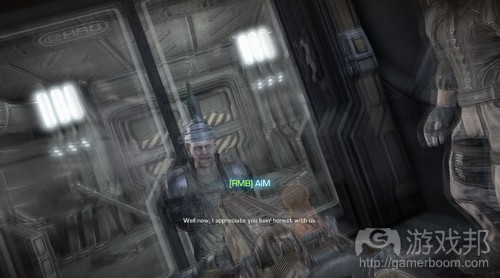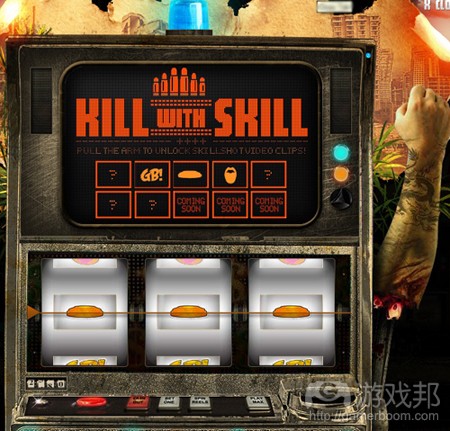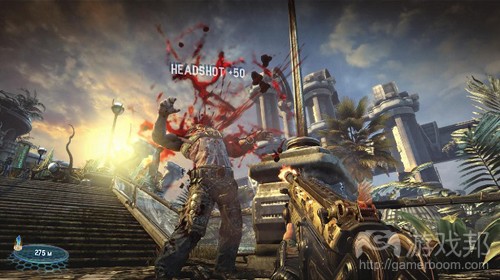分析射击游戏《子弹风暴》中的设计缺陷
作者:Eric Schwarz
发行于2011年2月份的《子弹风暴》是People Can Fly在被Epic Games收购后发行的第一款游戏。因为People Can Fly是《Painkiller》(游戏邦注:这是作者近十年来最喜欢的一款第一人称射击游戏)开发者,所以我对《子弹风暴》报以了满满的期待,希望能够在游戏中体验到紧张的行动,有趣且独特的武器,各式各样的敌人,新颖的关卡设计以及华丽的视觉效果。
但是当我玩了这款游戏后却发现,即使游戏图像还是那般出色,但是它却不再像以前的游戏那样能够牢牢吸引住我的注意力了。尽管游戏中也拥有一些有趣的核心行动,但是我却发现自己总是会不时地脱离游戏体验。所以我将在本篇文章中研究《子弹风暴》中一些值得怀疑的设计决策——从而决定我们是应该去完善还是直接删除它们。
烦人的介绍
《子弹风暴》最让人费解的一点便是它过度关注于讲故事。这款游戏在开始阶段便设置了大量的过场动画以及快速反应事件(QTE),让我总是忍不住地想要立刻终止游戏。我有这种想法也是情有可原的,因为当我开始玩《子弹风暴》时,我希望能够马上开始体验游戏行动,但是《子弹风暴》的“欢迎动画”却耗费了我大把的时间。
《子弹风暴》并未在初始时间公开游戏内容,而是强迫玩家花费30至40分钟去观看游戏的过场动画,包含大量快速反应事件的游戏玩法;“玩”大量的脚本序列内容;并阅读标准的教程内容。这些过场动画和倒叙服务有何意义?这是一款关于袭击变异人的游戏,有必要花费那么多时间去创造游戏背景和角色吗?但是当我们进入游戏不到10分钟便会发现游戏情节其实与这些理念一点关系都没有,所以这不仅是一种无聊的开场方式(尽管拥有华丽的视觉效果),同时也无关玩家今后的游戏体验。就拿《半条命2》来说吧,这款游戏拥有比《子弹风暴》更强大的叙述性,但是它却只用了5分钟时间便完成了后者需要在1个小时才能阐述完整的内容。
(我们要知道,当一款游戏开始出现快速反应事件时,它便开始出现问题了,也会逐渐变得无趣。)
除此之外,游戏花大量的时间去阐述的这些内容实际上却与游戏没有多大的关联。《子弹风暴》在开始阶段,即在向玩家解释核心游戏体验之前花了5分钟时间去介绍射击场(与接下来的游戏没有多大关系)。随后它又花了将近1个小时的时间去介绍游戏的核心机制——技巧杀戮。我就搞不清楚了,为何我必须坐在屏幕前花半个小时的时间观看如此冗长无趣的内容,迟迟等不到游戏的正式开始?既然子弹风暴的标语是“技巧杀戮”,那就让我马上感受这一体验啊!大多数游戏如果不能在10分钟内解释清楚核心内容,那就会让玩家感到无聊,但是《子弹风暴》却要求玩家在真正体验游戏乐趣之前浪费更多时间。
当玩家真正进入游戏环节时,他们便开始投身于各种屠杀与爆炸情节,冗长的游戏介绍才开始完全隐退。尽管如此我们也不能原谅这款游戏创造出如此啰嗦,无聊且没有意义的开场内容。我甚至难以想象游戏提供这些介绍的原理是什么。没有人理解为何游戏要让一个酗酒的醉汉Grey当主角,或者为何他国会如此关心那些开孔的纸板箱。虽然我认为这是一种讽刺的表现手法,但是即使这样我也不能忍受这款游戏强迫玩家忍受如此长时间无趣的介绍内容。
真的是技巧杀戮吗?
就像我之前所提到的,《子弹风暴》的核心游戏玩法是围绕着“技巧杀戮”,也就是各种枪支组合体——这取决于你是使用何种手段去杀死敌人,如环境,混战行动和枪支等,你都能够因此获得分数作为奖励。这些分数除了对你在在线排行榜上有影响外,它们同时也将被整合进游戏升级系统中,从而最终大大提高玩家在游戏中的购买能力以及对游戏武器的需求。
理论上看来这些想法都很棒。但是当被置于实践上时,我们却会发现技巧杀戮系统其实并不有趣,并且总是会遭到来自其它游戏机制的负面影响。作为游戏所拥有的少数创新理念之一(但是却不能发挥其最大潜能),这真的是一大败笔。
(《子弹风暴》在市场营销过程中着重突出了“技巧杀戮”这一标语,但是游戏中却未过多强调这一内容,甚至其刺激度还不如老虎机游戏。)
所以第一个主要问题是游戏很难有效地执行技巧杀戮,甚至只是将其随机地被分配在一些标准的游戏玩法中。而大多数技巧杀戮则包含以下内容:
*将敌人踢到一个危险的环境中而杀死他/她
*射击一个爆炸对象杀死敌人
*射击敌人身体的某个特殊部位而杀死他/她(通常是头部或腹部)
*使用枪的二次攻击模式杀死敌人
*结合混战和炮击杀死敌人
你是否能够在这些内容中发现一些疑点?其中有三点,即二次攻击,爆炸对象和头部射击是大多数玩家在任何一款射击游戏中都能够采取的措施。虽然这些内容需要玩家具有一定的技巧,但是它们却不具有任何创意。也就是说游戏中的奖励大多数是来自于那些与其它射击游戏相类似的内容。
而剩下的两种类型,即危险环境和混战组合虽然较为有趣,但是如果玩家知道这些内容其实也是关于袭击敌人的某个部位或使用皮带抽打敌人时,他们也会开始感到无聊。除此之外,在这款游戏中大多数技巧杀戮只能在一些特定情境中共存,而视觉效果则是用于区别它们的主要手段。就像将敌人踢到水里与将其踢到悬崖下其实在功能上是一致的,特别是在动作发生的10秒后这种同一性会变得更加明显。
(如果能够合理地使用技巧杀戮将能为游戏带来更多乐趣,但是实际上很多游戏中的技巧杀戮都很格式化,玩家很难从中感受到创造性。)
此外,我还认为技巧杀戮并不能真正测试玩家的战斗技巧,相反地它只能测试玩家的模式识别能力。大多数技巧杀戮只适用于一些特定的枪支,敌人或环境中,并且基本上每一种技巧杀戮都能置敌人于死地。这就意味着技巧杀戮并不是关于执行,而是关于识别敌人X与情境Y,并将这两者结合在一起。当游戏中具有风险/奖励时,执行技巧杀戮而获得奖励往往不具有太大的吸引力,特别是当玩家能够轻松地执行那些能生成较高分数的杀戮时。甚至到了游戏最后情况也未发生好转,即玩家不需要发挥更多创造性,并且他们也不需要使用各种技巧杀戮去消灭敌人。从字面意义来看机制只是一种“偏才”,它只能根据相同的主题而创造各种图像去表现深度。
最后,也是最致命的是——《子弹风暴》的技巧杀戮基本上只与风险和奖励有关,即如何做一些无意义的事或者如何获得最后的成功,并且游戏不合理地使用了一种恢复生命值系统并过分强调使用掩蔽物等。尽管游戏中也有《雷神之锤》类型的引诱物,但是因为游戏的节奏较慢所以这种设置反倒变得不合理了。为了争取15至20秒的时间,你需要隐藏在及胸高的墙壁后面10秒等待生命值的恢复。就像在《质量效应2》中选择“先锋”这一职业就会让人觉得太过鲁莽且具有风险,特别是在一款具有完善隐蔽系统的游戏中!而修正这一问题也很简单,你只要提供给玩家一个命值加成以换取技巧杀戮即可,对于他们来说这不仅是一种奖励同时也能够帮助他们获得生存。如此我们便能够有效地优化那些本来看起来太过直白的射击游戏。
关卡设计又如何?
《Painkiller》之所以如此吸引人主要是归功于它那巧妙的半开放式关卡设计。尽管游戏故事是以线性模式呈现出来,但是我们仍能在游戏环境中发现许多不同的内容(游戏邦注:并且它们也深刻影响着游戏玩法),不论是具有隐蔽物还是没有隐蔽物,并且环境中也涵括了好友和敌人这两种对立角色,而多关卡领域更是强调垂直性等。合理地分隔这些内容可以说是这款游戏成功的关键,但是最主要原因还是它能够让玩家在每次战斗遭遇中拥有不同的感受。
而《子弹风暴》给人的感觉就好象这是一款由计算机设计出来的游戏。更直白地讲,我认为这款游戏的关卡设计是我有史以来看过最无聊的设计。不得不承认它们的外观很出色,但是除了图像我便很难在这款游戏中找到其它具有实质性且真正有趣的内容了。
(如果从外观来看,《子弹风暴》的关卡真的非常优秀。但是从其它内容来看,它不仅未拥有交互式内容,同时其游戏功能也只是关于一些笔直狭窄的廊道和复制粘帖的竞技场争斗罢了。)
我在之前提到了快速反应事件会导致游戏的种种弊端,而不得不明确的是,快速反应事件正是《子弹风暴》游戏玩法的重要组成部分。不管游戏是关于“按压X键而幸存”还是关于不断发展的小游戏,即要求玩家不断按压鼠标按钮/触发器(反复进行5次或更多),或者是带有各种障碍的前进过程(游戏邦注:玩家必须用踢倒等方式消除种种障碍),《子弹风暴》的核心(如果不是关于射击)归根结底就是:玩家沿着廊道前行,并且在启动后每20秒按压一次指示按钮。
所以不言而喻,这并不是一个有趣的内容。但是为什么会出现这种情况呢?我想主要原因是游戏的每个单一行动都不能给予玩家足够的自由想象空间。举个例子来说吧,在《半条命2》中,游戏进一步分解了行动而让玩家拥有一定时间能够基于自己的节奏去探索环境,并最终找到继续前进的方法。但是《子弹风暴》却以放大的亮蓝色字母直接告诉玩家“踢这个东西”或“拉那个物体”。这完全是剥夺了玩家的想象自由,玩家在游戏世界中的探索只能演变成游戏引导着他们进入一个又一个战斗序列。这种设计太低估玩家的智商了。
尽管我能理解游戏中那些突出的内容,如爆炸障碍以及首次出现的交互式对象,但是《子弹风暴》竟然将这些内容贯穿于整个游戏中,并严重破坏了玩家探索并解决问题的过程,这便是我不能容忍的。
最糟糕的是游戏其实完全不需要这些内容。《子弹风暴》是一款游戏,是一款基于残忍模式的射击游戏,所以设计师既不需要每隔几分钟设置一些无趣的快速反应事件,也不需要在开始和结束时添加那些非交互式对话序列和过场动画。不要把我们这些玩家当成孩童而只是为我们呈现一些如“炸毁这堵脆弱的墙旁边的鲜红色油桶”之类的场景。大多数射击游戏(即使不是很出色)都能够提供给玩家一定程度的主导权让他们去解决谜题——有可能是射击,踢或丢掉某物。但是在《子弹风暴》中,玩家却只能选择踢,鞭打或炮击的其中一种方式,而不能同时使用这些方式。
不过有时候我们也能从《子弹风暴》的关卡设计中看到其创造性的体现。最让人印象深刻的便是在游戏序列中有三分之一的内容是玩家通过火箭发射装置远程控制着一只巨大的机器恐龙并撕裂别墅。与游戏中的其它内容不同的是,这一序列能够为游戏故事和关卡设计引进新的游戏机制和挑战(在早期阶段设有铺垫),并要求玩家能够在整个非常时期中改变策略。尽管这么做非常简单,但是这种改变却很好地体现出其它游戏内容所不具有的创造性。所以对于玩家来说这不仅非常有趣,同时也能够让他们表现出不同游戏玩法——如果《子弹风暴》中的每个关卡都具有这种创造性我们也不会觉得游戏过于单调了。
其它问题
我知道我过于吹毛求疵了,但是《子弹风暴》中还存在一些我不得不提的设计弊端!
*游戏中设有许多不能略过的过场动画(甚至在完成游戏后也还有)。至少应该让我能够避开介绍。
*不能有效地区分控制方式。例如,重装子弹的与其他互动方式的按键重叠了。我曾经多次尝试着为手枪重装子弹以执行任务,但是却反复因此丧命。
*糟糕的复活点设置。如果我死了,我就得浪费不必要的时间在廊道里转悠,踢门或者收集小物件之类才能再返回原点。
*如果你在发现了一个有利的技巧杀戮后死去了,你的数据库便不再保留关于该技巧的内容,即使你重新装载后也不会记得它了——尽管玩家能够凭借较高的分数而重新玩游戏。玩家必须通过分数去购买更多弹药,但是他们同时也需要利用分数去升级枪支。而我想说的是,我几乎从未购买过任何弹药。
*那些所谓极端复杂的模式总是非常简单,除了快速反应事件之外(它促成了我90%的死亡机率)。
*虽然游戏能够恢复玩家的生命值并重视使用遮蔽物,但是在游戏中许多遮蔽物都不够高,不足以完全遮挡住玩家的身体,这也就意味着很多时候玩家的头部会暴露在危险中。除此之外游戏在存档方面也不够完善,也就是说当玩家开始新的游戏挑战时并不能从之前的检查点再次开始游戏。
*大多数枪支能够使用的弹药非常有限——就像恢复生命值一样,游戏总是鼓励玩家避免使用那些奇特的武器和技巧杀戮。例如,“命值技巧杀戮”几乎成了玩家的主要弹药来源,它会进一步使玩家频繁使用这种武器,同时也能够帮助玩家争取到更多分数并获得升级。
结论
从很大程度上来看,《子弹风暴》还是一款非常优秀的游戏。从技术上来看它真的非常出色,游戏中的枪支设置都非常趣且匠心独运(甚至贯穿着史诗般的艺术性),射击者能够使用明亮色彩的枪支与外星人和怪物展开一系列暴力抗衡,并且这都是发生在神秘的中东地区。除此之外游戏中也具有一些出色的创造性机制——诉说着我们这一年代中奇特的一切。
但是不管怎么样,游戏中巨大的设计缺陷和疏忽(如果能够投入更多努力或更加谨慎便能够解决)却始终制约着游戏的发展。游戏中的技巧杀戮应该是关于技巧和才能而不是提供给玩家大量不成比例的XP奖励和无聊任务的反馈。设计师应该使用一些具有特殊影响力的技巧杀戮去武装敌人和关卡,而不只是反复根据相同的主题创造出一些外观不同的内容。设计师们应该将游戏中的快速反应事件调整为真正有趣的游戏机制,要不就直接删掉它们。最后,对于那些带有故事序列和过场动画的介绍内容更应该当机立断地删除!
《子弹风暴》虽然具有不错的基本原理,但是其真正的实践却糟蹋了这些内容。所以我真心希望People Can Fly能够不断强化自己的创造性和射击技能,并在下一款游戏中做出有效的改善。
(本文为游戏邦/gamerboom.com编译,拒绝任何不保留版权的转载,如需转载请联系:游戏邦)
Bulletstorm: When Presentation Isn’t Enough
by Eric Schwarz
Bulletstorm, released in February 2011, is the first game by People Can Fly after they were purchased by Epic Games. As the developers of Painkiller, one of my favorite first-person shooters of the decade, I went into Bulletstorm expecting intense action, entertaining and unique weapons, varied enemies, and great, inventive level design. Oh, and fantastic visuals as well.
While the graphics behind the game are as strong as ever, though, Bulletstorm completely missed its mark for me. Although it still manages to have some enjoyable core action, I found myself constantly being pulled out of the experience. In this article, I’ll be examining some of the many, many questionable design decisions in Bulletstorm, both ideas that could have been improved through better execution, and ones that should have simply been left on the cutting room floor.
Introductions Aren’t My Strong Suit
The first, and most completely perplexing part of Bulletstorm for me, is the surprisingly heavy focus on storytelling. The opening hour or so of Bulletstorm has a ratio of cutscenes and quick-time-events to gameplay that I almost stopped playing outright. I think it’s fair of me to, when I start up something called Bulletstorm, expect a game that gets right to the action, but Bulletstorm more than wears out its welcome.
Out of the initial time spent with the game, approximately 30-40 minutes are spent watching cutscenes or “playing” heavily scripted sequences, and the bulk of gameplay involves performing quick-time events and going through standard tutorial motions. What purpose do all these cutscenes and flashbacks serve? This is a game about impaling mutants on gigantic cacti – why is it so necessary to spend so much time establishing a setting and characters? Most of those ideas are all eradicated by the plot about ten minutes into the game, anyway, so not only is the beginning boring (despite the pretty visuals), it’s also completely irrelevant to anything going on in the rest of the game. Half-Life 2, a game with ten times the narrative weight and substance than Bulletstorm, accomplished more in its opening 5 minutes than this game can in an hour.
You know a game’s got issues when it starts with a quick-time-event. A tasteless one, too.
Moreover, of all that time spent, much of it is completely irrelevant to the actual game. About five minutes of the opening is dedicated to a shooting gallery section which has just about no relation to the rest of the game and occurs before the player has even been introduced to the core gameplay experience. In fact, it takes close to an hour to even be introduced to the game’s core defining mechanic, skillshots. Why am I being made to sit through this lengthy, uninteresting sequence for over a half-hour before the game even starts? This game is called Bulletstorm, and its tagline is “kill with skill” – so let me do that! Most games begin to bore players if they can’t get into the meat of a game in 10 minutes, and Bulletstorm has the gall to think it’s worthy of asking even more time before it lets the player have fun.
Once the game actually gets into motion about an hour in, things generally improve, and the seriousness of the introduction completely evaporates as the bandit slaughter and explosions begin, but there is no excuse for how overblown, bloated, poorly paced, lengthy, and completely pointless Bulletstorm’s opening act is. It’s hard to imagine just how this segment came to be, what the rationale was. This game has the intellectual capability and grace of a drunk rhino – nobody is here to understand the twisted alcoholism-stained motives of grizzled protagonist Grey, or why he cares so deeply about his crew of cardboard cut-outs. I have the sneaking suspicion this was all intended to be ironic, but that’s no excuse to force the player to endure such a poor intro sequence.
Skillshots, or Not
As I mentioned, the core gameplay of Bulletstorm revolves around “skillshots”, which could adequately be described as gun combos – depending on your means of killing enemies, whether that’s using the environment, melee-type actions, guns, or all in concert, you’re rewarded with points. These points, in addition to tying into the game’s online leaderboards (the only real “multiplayer” the game has), also feed into the game’s upgrade system, which basically boils down to purchasing capacity increases and secondary fire options for the game’s firearms.
On paper, all of this sounds great. The problem with the skillshot system is that, as executed, it isn’t particularly fun or skillful, and is actually undermined by other mechanics in the game. It’s a real shame, too, because it’s one of the few original ideas the game has, and it isn’t even able to use it to its full potential.
The “kill with skill” tagline featured heavily in Bulletstorm’s marketing, but the in-game manifestation isn’t too much more exciting than a slot machine.
The first major issue is that skillshots are just not hard to perform, and many occur near-randomly in standard gameplay. The vast majority involve the following:
Killing an enemy by kicking him/her into an environmental hazard
Killing an enemy by shooting an explosive object
Killing an enemy by shooting him/her in a specific body part (usually the head or groin)
Killing an enemy by using a gun’s secondary fire
Killing an enemy by combining melee attacks and gunfire
Noticed anything suspicious? Three of these – secondary attacks, explosive objects, and headshots – are all things that most players do in virtually every other shooter. These might require some modicum of skill, but they aren’t really creative acts, and certainly not original. Already, a majority of the game’s rewards come from doing things that are standard fare in shooters.
The two remaining categories, environmental hazards and melee combos, are a bit more interesting, but even these become stale once it becomes clear that these almost exclusively revolve around kicking an enemy at something or using the Leash, which is able to stun and throw enemies around. Moreover, the vast majority of skillshots are only compatible in very specific situations, and the things that differentiate them are basically aesthetic. Kicking an enemy into the water vs. off a cliff is functionally identical, which becomes apparent after about 10 seconds of gameplay
Skillshots are fun to pull off, but many are so routine and standard that they rarely feel special or require creativity.
Additionally, and damningly in my opinion, skillshots don’t really test your combat skill – rather, they test pattern recognition. Most skillshots are only applicable to specific guns, enemies and environmental situations, and almost every single skillshot is instantly lethal to that enemy. This means, that skillshots aren’t really about executing – they’re about recognizing enemy X, situation Y, and then putting two and two together. While there is risk/reward in play, the reward for performing skillshots isn’t particularly compelling, especially as so many kills that provide high point values are so easy to do. Even near the end of the game, things do not improve – the player doesn’t need to get creative, enemies do not require multiple skillshots to take down, and so forth. The mechanic literally is a one-trick pony, only given an illusion of depth by having so many aesthetic variations on the same themes.
Last, the final nail in the coffin – Bulletstorm’s skillshots are all about risk and reward, about going in to do reckless things and coming out on top, covered in blood… yet the game sports a regenerating health system and a very heavy emphasis on using cover… yeah, uh-oh. Although the temptation to bunny-hop around Quake-style is always there, it’s rarely possible because the game moves at a very slow pace. Shoot for 15-20 seconds, and you need to hide behind a chest-high wall for another 10 seconds as your health comes back. Playing a Vanguard in Mass Effect 2 felt more reckless and risky, and that was in a game with a formalized cover system! Fixing this would have been pretty easy, as well – giving the player a health bonus for a skillful kill would have made skillshots both rewarding and necessary for survival. As it stands, it’s just a way to pretty up what is otherwise a very straightforward shooter.
Level Design? What’s That?
One of the things that made Painkiller so much fun was its smart and semi-open level design. While the game was definitely linear, it had a ton of variety in its environments which directly impacted gameplay… situations with cover, without cover, where the environment was both a friend and enemy, multi-level areas with an emphasis on verticality, and so on. The unhingedness of it all was probably the key to its success, but even so the game was so much fun because it made each combat encounter feel different.
Bulletstorm feels like it was designed by a computer. That’s not an understatement – I think it may have some of the most boring and by-the-numbers level design I have ever seen. It’s beautiful, yes, and I think the game’s artists deserve a huge amount of credit for what they did there – but graphics aside, there just isn’t anything substantial or interesting to see or do (with very rare exceptions).
Bulletstorm’s levels sure are pretty. Too bad they’re almost entirely non-interactive and rarely feature more than straight, narrow corridors and copy-paste arena fights.
I mentioned quick-time-events earlier, but truth be told, they make up a surprisingly large portion of Bulletstorm’s gameplay. Whether it’s an actual “press X not to die” situation, or a climbing mini-game that requires mashing the mouse buttons/triggers one after the other (which is repeated about five times more often than it should be), or a standard procession of obstacles which must be kicked down or pulled away with the Leash, the core of Bulletstorm, when not shooting anything, boils down to: walk down a narrow corridor, and every 20 seconds, press the indicated button when prompted.
I think it goes without saying: this is not fun. But why is this? I think it comes down mostly to the way the game prompts and guides every single action that isn’t giving someone .44 caliber brain surgery. Whereas games like Half-Life 2 are able to break up their action by giving the player some time to explore an environment at his or her own pace, and then find a solution on how to proceed, Bulletstorm flat-out tells you “KICK THIS THING” or “PULL THAT THING” in big, bright blue letters. Any illusion of freedom is completely sucked away, and what should be breaks in the combat to absorb, explore and appreciate the hyper-detailed world are instead turned into an opportunity to usher the player to the next combat sequence. Look, Bulletstorm – just because you are a stupid game does not mean you need to assume I am stupid.
While I can understand highlighting things like explosive barrels and other interactive objects the first time around, Bulletstorm does this throughout its entire length, and ruins all sense of exploration and problem-solving as a result.
The worst part is how completely unnecessary all of this is. Bulletstorm is a game that, again, is about shooting people in ridiculous and satisfyingly brutal fashion. It does not need these unfun quick-time-events every few minutes, nor does it need non-interactive dialogue sequences and cutscenes bookending everything. It does not need to treat me like a moron and baby me through scenarios which never, ever go beyond “gee, maybe I should blow up the bright red barrel next to this breakable wall.” Most shooters, even dumb ones, are content to give the player a degree of authorship in solving puzzles – maybe you can shoot something, or kick it, or throw something, etc. In Bulletstorm, a door can either be opened with a kick, or the Leash, or gunfire – not “all of the above.”
There are a few times when Bulletstorm ever shows any real ingenuity or inventiveness in level design. One of the most memorable comes in a sequence about a third of the way through the game, where the player remote-controls a gigantic robot dinosaur with rocket launchers attached to it and tears through a villa (now we’re talking!). Unlike most parts of the game, this sequence actually introduces a new play mechanic and challenges into both the narrative and the level design (there’s some foreshadowing for it early on), and requires the player to change strategy for the duration. While the segment is extremely easy, this kind of change-up shows a degree of creativity that is almost entirely missing from the rest of the game. It’s fun, and actually plays differently – whereas every level in the game should have been like this, refreshing, over the top, and ludicrous, in Bulletstorm it’s a rare treat in between the rest of the monotony.
Other Issues
I know I’m nitpicking here, but here’s another list of design sins that Bulletstorm committed that I can’t fit anywhere else.
Many unskippable cutscenes, even after you’ve finished the game. At least I can avoid the intro.
Poor context-sensitive controls. Reload is mapped to the same key as interact. There were multiple times where I performed an action when I was trying to reload my gun, once or twice resulting in death.
Poor checkpoint placement. If I die, don’t make me waste a minute running down a corridor, kicking down doors, and re-collecting doodads.
If you discover a tough skillshot and die, you don’t retain knowledge of it in your database upon reloading… despite Bulletstorm being all about replaying for a higher score.
Most ammo must be purchased with points, but guns must also be upgraded with points. Suffice to say, I almost never bought any ammo.
Very hard mode is quite easy, except for quick-time-events, which made up 90% of my deaths.
The game has regenerating health and a heavy emphasis on using cover, yet a lot of the cover in the game isn’t tall enough to shield you fully, meaning your head gets blown off with surprising regularity even when you’re ducked behind something.
No hard saves, which means starting a new game (which I did to grab screenshots for this article) kills your existing checkpoint.
Very limited ammo for most guns – like regenerating health, the game encourages you to avoid using the more exotic weapons and skillshots. Like “health for skillshots”, making them the player’s main source of ammo would have further encouraged the use of those cool guns while also focusing the point system towards upgrades.
Closing Thoughts
The regrettable thing about this is that Bulletstorm is, for the most part, a competent game. It’s not extremely short unlike most other shooters, it’s technically very competent, the guns are all fun to use and fairly distinct, it’s got a reasonably unique look (even with Epic’s artistry all over it), and it goes back to a time where shooters could have bright colors, cartoonish violence, aliens and monsters, and didn’t take place in a nebulously defined portion of the Middle East. Heck, it’s even got a couple of original mechanics – and that’s saying something in this day and age.
And yet, it also succumbs to huge design flaws and oversights which probably could have been solved with more effort and care. Skillshots needed to be about skill and talent instead of a way of giving out disproportionately large XP rewards and feedback for mundane tasks. Enemies and levels needed to be built around the idea of using special skillshots with unique effects, instead of just creating aesthetic variations on the same repeating themes over and over. The quick-time-events should have been either turned into a legitimate and interesting game mechanic, or eliminated. And that introduction, along with all those story sequences and cutscenes, really, really needed to be cut.
Bulletstorm finds itself in the peculiar situation of nailing all the fundamentals, and then completely botching the landing. Here’s hoping People Can Fly will be able to stretch their creative and design muscle a little bit more for their next game, whatever it might be.(source:GAMASUTRA)











































 闽公网安备35020302001549号
闽公网安备35020302001549号